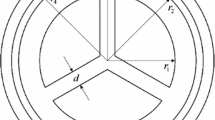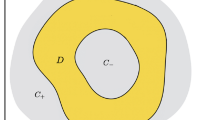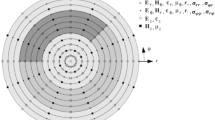Abstract
This paper provides an exact asymptotic analysis regarding the low-frequency dispersion characteristics of a multilayered coaxial cable. A layer-recursive description of the dispersion function is derived that is well suited for asymptotic analysis. The recursion is based on two well-behaved (meromorphic) subdeterminants defined by a perfectly electrically conducting (PEC) and a perfectly magnetically conducting termination, respectively. For an open waveguide structure, the dispersion function is a combination of two such functions, and there is only one branch point that is related to the exterior domain. It is shown that if there is one isolating layer and a PEC outer shield, then the classical Weierstrass preparation theorem can be used to prove that the low-frequency behavior of the propagation constant is governed by the square root of the complex frequency, and an exact analytical expression for the dominating term of the asymptotic expansion is derived. It is furthermore shown that the same asymptotic expansion is valid to its lowest order even if the outer shield has finite conductivity and there is an infinite exterior region with finite nonzero conductivity. As a practical application of the theory, a high-voltage direct current (HVDC) power cable is analyzed and a numerical solution to the dispersion relation is validated by comparisons with the asymptotic analysis. The comparison reveals that the low-frequency dispersion characteristics of the power cable is very complicated and a first-order asymptotic approximation is valid only at extremely low frequencies (below 1 Hz). It is noted that the only way to come to this conclusion is to actually perform the asymptotic analysis. Hence, for practical modeling purposes, such as with fault localization, an accurate numerical solution to the dispersion relation is necessary and the asymptotic analysis is useful as a validation tool.







Similar content being viewed by others
Notes
To make the square root unique, its phase angle is chosen as \(-\pi <\arg \kappa _i\le 0\).
Note that the TE and TM field components are generally coupled via the boundary conditions but are always decoupled for the axial-symmetric \(\mathrm TM _{0n}\) and \(\mathrm TE _{0n}\) modes.
References
Amekawa N, Nagaoka N, Baba Y (2003) Derivation of a semiconducting layer impedance and its effect on wave propagation characteristics on a cable. IEE proceedings on generation, transmission and distribution 150(4):434–441
Boggs S, Pathak A, Walker P (1996) Partial discharge. XXII. High frequency attenuation in shielded solid dielectric power cable and implications thereof for PD location. IEEE Electr Insulation Mag 12(1):9–16
Lundbäck J, Nordebo S, Biro T (2008) A digital directional coupler with applications to partial discharge measurements. IEEE Trans Instrum Meas 57(11):2561–2567
Nordebo S, Nilsson B, Biro T, Cinar G, Gustafsson M, Gustafsson S, Karlsson A, Sjöberg M (2011) Electromagnetic dispersion modeling and measurements for HVDC power cables. Technical Report LUTEDX/(TEAT-7211)/1-32/(2011), Lund University, Department of Electrical and Information Technology, P.O. Box 118, S-221 00 Lund, Sweden. http://www.eit.lth.se
Pommerenke D, Strehl T, Heinrich R, Kalkner W, Schmidt F, Weissenberg W (1999) Discrimination between interal PD and other pulses using directional coupling sensors on HV cable systems. IEEE Trans Dielectr Electr Insulation 6(6):814–824
Steinbrich K (2005) Influence of semiconducting layers on the attenuation behaviour of single-core power cables. IEE proceedings on generation, transmission and distribution 152(2):271–276
Stone GC (2005) Partial discharge diagnostics and electrical equipment insulation condition assessment. IEEE transactions on dielectrics and electrical insulation 12(5):891–905
Veen J (2005) On-line signal analysis of partial discharges in medium-voltage power cables. PhD thesis, Eindhoven University of Technology, The Netherlands
Gardiol FE (1987) Lossy transmission lines. Artech House, Boston
Carson JR, Gilbert JJ (1921) Transmission characteristic of the submarine cable. J Franklin Inst 192(6):705–735
Lundstedt J (1995) Condition for distortionfree transmission lines with a nonuniform characteristic impedance. IEEE Trans Microwave Theory Tech 43(6):1386–1389
Papazyan R, Pettersson P, Pommerenke D (2007) Wave propagation on power cables with special regard to metallic screen design. IEEE Trans Dielectr Electr Insulation 14(2):409–416
Tai CT (1983) Dyadic Green’s functions for a coaxial line. IEEE Trans Antennas Propagat 31(2):355–358
Hörmander L (1983) The analysis of linear partial differential operators I. Grundlehren der mathematischen Wissenschaften 256. Springer, Berlin
Collin RE (1991) Field theory of guided waves, 2nd edn. IEEE Press, New York
Felsen LB, Marcuvitz N (1994) Radiation and scattering of waves. IEEE Press, Piscataway (Originally published by Prentice-Hall in 1973)
Olyslager F (1999) Electromagnetic waveguides and transmission lines. Clarendon Press, Oxford
Olver FWJ (1997) Asymptotics and special functions. A K Peters, Ltd., Natick
Olver FWJ, Lozier DW, Boisvert RF, Clark CW (2010) NIST handbook of mathematical functions. Cambridge University Press, New York
Nilsson B, Cinar G, Nordebo S, Cinar OY (2012) Asymptotic methods for long distance monitoring of power cables. In: The 6th international conference on inverse problems: modeling and simulation, pp 206–207. Antalya, Turkey, May 2012
Jackson JD (1999) Classical electrodynamics, 3rd edn. Wiley, New York
Pozar DM (2005) Microwave engineering, 3rd edn. Wiley, New York
Boström A, Kristensson G, Ström S (1991) Field representations and introduction to scattering, acoustic, electromagnetic and elastic wave scattering. In: Varadan VV, Lakhtakia A, Varadan VK (eds) Transformation properties of plane, spherical and cylindrical scalar and vector wave functions, Chap. 4. Elsevier Science Publishers, Amsterdam, pp 165–210
Acknowledgments
This work was supported in part by the Swedish Research Council (VR) and ABB AB. The authors are also grateful to ABB AB for providing the opportunity to perform the cable measurements on their premises.
Author information
Authors and Affiliations
Corresponding author
Rights and permissions
About this article
Cite this article
Nordebo, S., Nilsson, B., Gustafsson, S. et al. Low-frequency dispersion characteristics of a multilayered coaxial cable. J Eng Math 83, 169–184 (2013). https://doi.org/10.1007/s10665-012-9616-3
Received:
Accepted:
Published:
Issue Date:
DOI: https://doi.org/10.1007/s10665-012-9616-3




